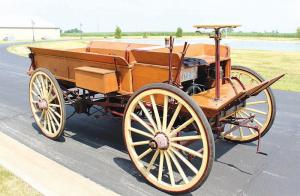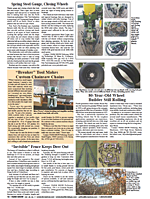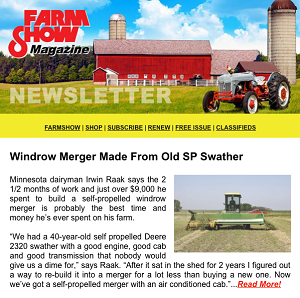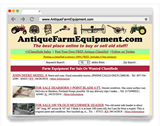When Is A Truck Not Really A Truck?
 ✖  |
The answer to the question is that a truck isnít really a truck when itís actually a motorized Eldridge wagon built in 1903. However, the state of Iowa titled it as a truck because a serial number had been stamped into its frame. It also has a small engine, transmission and steering system. The restored vehicle is now on display at the Iowa 80 Trucking Museum, alongside more than 100 other vintage trucks.
††††Truck collectors observing the Eldridge sometimes view it as more of a wagon than a truck. Thatís understandable, considering it has large wooden-spoked wheels for better ground clearance, a wooden cargo box, and a wooden bench for the driver and passenger. Fitted with a wagon pole and doubletrees, a team of horses could easily draw it. The Eldridge, however, has an engine and many unique features beneath and above that wooden exterior.
††††It was built by the Eldridge Welding and Machine Company of Des Moines, Iowa. George Eldridge and his inventive employees configured this first-of-a-kind self-powered vehicle to move supplies and equipment between the factoryís buildings. They installed a small engine, drive system and steering mechanism underneath a horse-drawn wagon, well before Henry Ford built his first Model T in 1908. Iowa 80 Museum Curator Dave Meier says the vehicle might be the first motorized truck ever built in the U.S. Itís also the oldest truck in the easily accessible museum on I-80, west of the Quad Cities at Walcott, Iowa.
††††A small 2-cyl, 8-hp engine powers the Eldridge, with a friction drive mechanism to power the wheels. The engine turns a flywheel, which rubs against a perpendicular wheel. This transfers power to a shaft and sprocket. Large roller chains thread over cogs on the inside of the rear wheels. Three speeds are possible depending on where the two friction wheels engage. Shifting is controlled by a lever that extends up to the driver. Another lever operates a brake.
††††A small measure of load cushioning is supplied by leaf springs attached to the chassis under the cargo box. An 8-leaf transverse spring is under the rear of the cargo box.
††††Eldridge possibly built two or three of the vehicles. According to the museum, it has the only one in existence. Credit for restoring and preserving it goes to several people.
††††Larry Crist says his father, Owen, who ran an auto body shop in Des Moines, bought the vehicle sometime in the late 1940s or early 1950s. It had sat unused for decades with broken wheels, rotted wood and an unresponsive engine. Crist spent several years trying to restore it. In the late 1960s, he moved it to a barn on his farm, where it sat on a dirt floor.
††††Twenty years later, it was moved to an auto body service shop under the guidance of Cristís sons, Larry and Bill. They, along with Wayne Allen, who soaked the engine for a year to free up the crankshaft and pistons, completed its restoration by 1986. Larry Crist stored it until selling it to the I-80 museum in 2020. Now, its museum-quality condition is maintained by Mark Catlett and Billy Moon, grandson of the museumís founders.
††††Visitors admire the vehicleís large spoked wooden wheels, crafted by Amish wheelwrights. They peer at pipes beneath the box and realize theyíre part of the engineís exhaust system. They examine the nearly vertical steering shaft and horizontal steering wheel, wondering how anyone could drive it. Then they realize the vehicle was built for work, not for fun. It hauled the companyís goods from one building to another at no more than 10 mph, so steering wasnít a top priority.
††††Meier says the Eldridge was definitely built to meet a need, and he often wonders why the company didnít expand its use by adding a cab or enclosure to protect the driver and passenger from the elements.
††††Contact: FARM SHOW Followup, Iowa 80 Trucking Museum, 507 Sterling Dr., Walcott, Iowa 52773 (ph 563-468-5500; www.Iowa80truckingmuseum.com).

Click here to download page story appeared in.
Click here to read entire issue
When Is A Truck Not Really A Truck?
The answer to the question is that a truck isnít really a truck when itís actually a motorized Eldridge wagon built in 1903. However, the state of Iowa titled it as a truck because a serial number had been stamped into its frame. It also has a small engine, transmission and steering system. The restored vehicle is now on display at the Iowa 80 Trucking Museum, alongside more than 100 other vintage trucks.
Truck collectors observing the Eldridge sometimes view it as more of a wagon than a truck. Thatís understandable, considering it has large wooden-spoked wheels for better ground clearance, a wooden cargo box, and a wooden bench for the driver and passenger. Fitted with a wagon pole and doubletrees, a team of horses could easily draw it. The Eldridge, however, has an engine and many unique features beneath and above that wooden exterior.
It was built by the Eldridge Welding and Machine Company of Des Moines, Iowa. George Eldridge and his inventive employees configured this first-of-a-kind self-powered vehicle to move supplies and equipment between the factoryís buildings. They installed a small engine, drive system and steering mechanism underneath a horse-drawn wagon, well before Henry Ford built his first Model T in 1908. Iowa 80 Museum Curator Dave Meier says the vehicle might be the first motorized truck ever built in the U.S. Itís also the oldest truck in the easily accessible museum on I-80, west of the Quad Cities at Walcott, Iowa.
A small 2-cyl, 8-hp engine powers the Eldridge, with a friction drive mechanism to power the wheels. The engine turns a flywheel, which rubs against a perpendicular wheel. This transfers power to a shaft and sprocket. Large roller chains thread over cogs on the inside of the rear wheels. Three speeds are possible depending on where the two friction wheels engage. Shifting is controlled by a lever that extends up to the driver. Another lever operates a brake.
A small measure of load cushioning is supplied by leaf springs attached to the chassis under the cargo box. An 8-leaf transverse spring is under the rear of the cargo box.
Eldridge possibly built two or three of the vehicles. According to the museum, it has the only one in existence. Credit for restoring and preserving it goes to several people.
Larry Crist says his father, Owen, who ran an auto body shop in Des Moines, bought the vehicle sometime in the late 1940s or early 1950s. It had sat unused for decades with broken wheels, rotted wood and an unresponsive engine. Crist spent several years trying to restore it. In the late 1960s, he moved it to a barn on his farm, where it sat on a dirt floor.
Twenty years later, it was moved to an auto body service shop under the guidance of Cristís sons, Larry and Bill. They, along with Wayne Allen, who soaked the engine for a year to free up the crankshaft and pistons, completed its restoration by 1986. Larry Crist stored it until selling it to the I-80 museum in 2020. Now, its museum-quality condition is maintained by Mark Catlett and Billy Moon, grandson of the museumís founders.
Visitors admire the vehicleís large spoked wooden wheels, crafted by Amish wheelwrights. They peer at pipes beneath the box and realize theyíre part of the engineís exhaust system. They examine the nearly vertical steering shaft and horizontal steering wheel, wondering how anyone could drive it. Then they realize the vehicle was built for work, not for fun. It hauled the companyís goods from one building to another at no more than 10 mph, so steering wasnít a top priority.
Meier says the Eldridge was definitely built to meet a need, and he often wonders why the company didnít expand its use by adding a cab or enclosure to protect the driver and passenger from the elements.
Contact: FARM SHOW Followup, Iowa 80 Trucking Museum, 507 Sterling Dr., Walcott, Iowa 52773 (ph 563-468-5500; www.Iowa80truckingmuseum.com).
To read the rest of this story, download this issue below or click
here to register with your account number.







